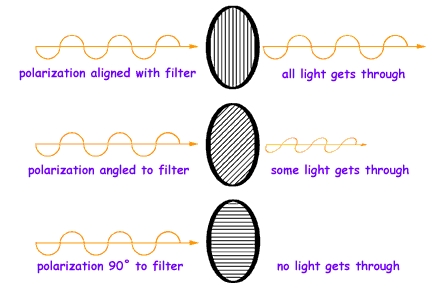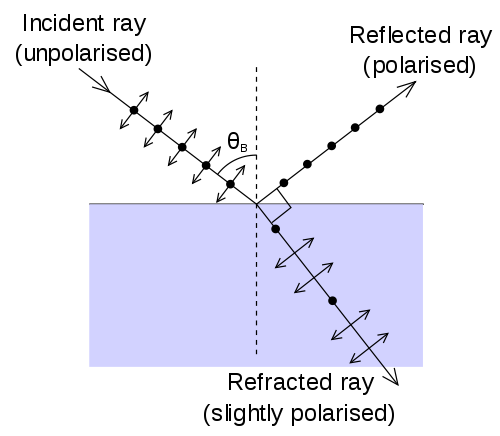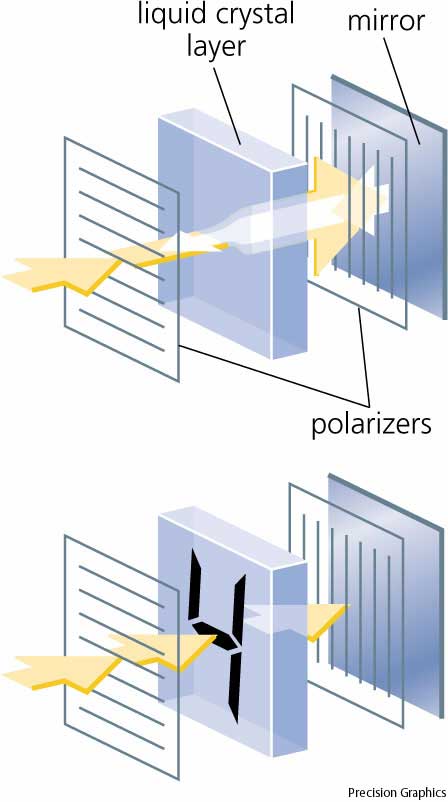
Polarization
Polarization
By convention, the polarization of light is described by specifying the orientation of the wave's electric field at a point in space over one period of the oscillation. When light travels in free space, in most cases it propagates as a transverse wave—the polarization is perpendicular to the wave's direction of travel. In this case, the electric field may be oriented in a single direction (linear polarization), or it may rotate as the wave travels (circular or elliptical polarization). In the latter cases, the oscillations can rotate either towards the right or towards the left in the direction of travel

Unpolarized light
Most sources of electromagnetic radiation contain a large number of atoms or molecules that emit light. The orientation of the electric fields produced by these emitters may not be correlated, in which case the light is said to be unpolarized.
Circular polarization filter

Brewster's angle
Brewster's angle (also known as the polarization angle) is an angle of incidence at which light with a particular polarization is perfectly transmitted through a transparent dielectric surface (it does not work for a metal eg. mirror), with no reflection. When unpolarized light is incident at this angle, the light that is reflected from the surface is therefore perfectly polarized. This special angle of incidence is named after the Scottish physicist Sir David Brewster (1781–1868).
![]()
For a glass medium (n2 ≈ 1.5) in air (n1 ≈ 1), Brewster's angle for visible light is approximately 56°, while for an air-water interface (n2 ≈ 1.33), it is approximately 53°

Applications
Polarization by scattering is observed as light passes through the atmosphere. The scattered light produces the brightness and color in clear skies. This partial polarization of scattered light can be used to darken the sky in photographs, increasing the contrast. This effect is easiest to observe at sunset, on the horizon at a 90° angle from the setting sun. Another easily observed effect is the drastic reduction in brightness of images of the sky and clouds reflected from horizontal surfaces (see Brewster's angle), which is the main reason polarizing filters are often used in sunglasses.

Also frequently visible through polarizing sunglasses are rainbow-like patterns caused by color-dependent birefringent effects, for example in toughened glass (e.g., car windows) or items made from transparent plastics.

The role played by polarization in the operation of liquid crystal displays (LCDs) is also frequently apparent to the wearer of polarizing sunglasses, which may reduce the contrast or even make the display unreadable.

Biology
Many animals are capable of perceiving some of the components of the polarization of light, e.g. linear horizontally polarized light. This is generally used for navigational purposes, since the linear polarization of sky light is always perpendicular to the direction of the sun. This ability is very common among the insects, including bees, which use this information to orient their communicative dances. Polarization sensitivity has also been observed in species of octopus, squid, cuttlefish, and mantis shrimp. In the latter case, one species measures all six orthogonal components of polarization, and is believed to have optimal polarization vision.[8] The rapidly changing, vividly colored skin patterns of cuttlefish, used for communication, also incorporate polarization patterns, and mantis shrimp are known to have polarization selective reflective tissue. Sky polarization was thought to be perceived by pigeons, which was assumed to be one of their aids in homing, but research indicates this is a popular myth.
The naked human eye is weakly sensitive to polarization, without the need for intervening filters. Polarized light creates a very faint pattern near the center of the visual field, called Haidinger's brush. This pattern is very difficult to see, but with practice one can learn to detect polarized light with the naked eye.
 Simulated appearance of Haidinger's brush for vertically polarized light. Size and intensity exaggerated for clarity. Actual rotational presentation will vary with polarization of light source.
Simulated appearance of Haidinger's brush for vertically polarized light. Size and intensity exaggerated for clarity. Actual rotational presentation will vary with polarization of light source.